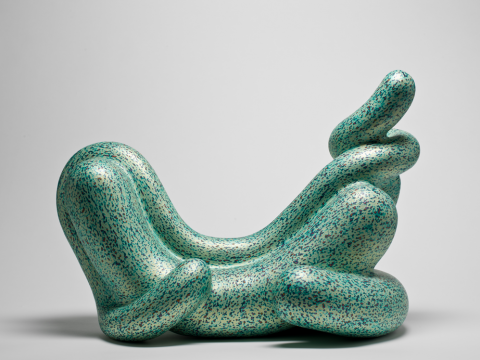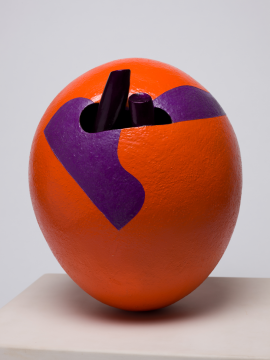“Ken Price Sculpture: A Retrospective” at LACMA, originally published on Glasstire Southern California,
I don’t know how it will play in Texas when it comes to the Nasher Sculpture Center in February 2013, but Ken Price’s magnificent exhibition at the Los Angeles County Museum of Art is so thoroughly suffused with the bittersweet aura of a memorial that it’s impossible not to be thrilled by the joy that spills from just about everything in it, and saddened by the fact that those days are over. The show includes pieces from every body of work the wildly inventive artist has made over the last half century. Price died on February 24, 2012 at his home/studio in Taos, New Mexico after a long battle with cancer. He kept working right up to the end, and his sculptures from 2011 and 2012 are among the best he has made: at once muscular and funny and even more whiplash-efficient in their capacity to compress loads of emotion—and expansive understanding—into modest dimensions, whose humility is humbling.
While Price was at work on these pieces, which spun, with just the right mix of surprise and rightness, out of everything that preceded them, he was also involved in the organization of the final exhibition that he would play a part in presenting. Thoughtfully organized by Stephanie Barron, senior curator of modern art, and graciously displayed in galleries nicely designed by Price’s lifelong friend, Frank O. Gehry, Ken Price Sculpture: A Retrospective is an unforgettable extravaganza that reveals, like all great, start-to-finish surveys of great artists’ oeuvres, a consciousness in action.
In Price’s case, visitors are treated to ample evidence of an agile mind that never tired of noodling around in the muck it knew best. He did so with the simple purpose of finding enlivening surprises in out-of-the-way places—in overlooked nooks and crannies, in seemingly incidental details and in a medium so undervalued in the 1960s, ’70s and ’80s that it all but screamed “underdog”—or “nut job”—at anyone who approached it with real ambition, a.k.a. sculptural seriousness. To visit Price’s quietly ravishing exhibition is to see an American original: A hard-working pragmatist who was also an extremely refined hedonist and a virtuoso combiner of ideas that make the phrase “strange bedfellows” seem to be middle-of-the-road, run-of-the-mill, and not nearly as much fun as his deliciously promiscuous fusions of life’s high points would prove to be.
Never buying into the idea that pleasure and labor worked at cross-purposes, that power and intimacy occupied opposite ends of the spectrum, that formal rigor and freewheeling improvisation were antithetical, that painting and sculpture were their own things, that size and scale were intrinsically linked and that clay was incapable of sustaining artistic ambitions, Price put love front-and-center. He embraced its transformative complexities in works both eccentric and purposeful, timely and timeless, down-to-earth and out-of-this-world.

Ken Price, “Underhung” (1997) Fired and painted clay, 23 ½ x 21 ½ x 16 in., © Ken Price, photograph © Fredrik Nilsen
Installed in reverse chronological order, Ken Price Sculpture: A Retrospective demonstrates from the get-go that it doesn’t make any sense to treat clay as a second-class citizen among its artistic brethren, painting and sculpture. This is partly because this age-old medium is perfectly suited to our multi-tasking, switch-hitting, double-duty times and partly because of what Price does with it: turn mud into phenomenally fascinating, one-of-a-kind objects whose animated forms suggest stories of all shapes and stripes and whose sinuous surfaces, ablaze with speckled rainbows of high-keyed tints and tones, make comparisons to contemporary painting seem both unfair and beside the point. The primordial stew in which his works burble exists in the present, where firework-style impulses pinball around your neural circuitry, from the base of your lizard brain to the highest reaches of your frontal lobes.
Long before you fall under the spell of any of the 11 masterpieces in the first gallery (all made between 2000 and 2011), it’s clear that you’re in the presence of something special. It is something which can neither be confined to the craft ghetto of straight-laced functionalism nor to the art ghetto of excessively professionalized preciousness, where symbolic gestures seem more concerned with the propriety of footnotes than attuned to the fact that viewers have feet, which give each of us the freedom to walk away from art incapable of making us dance, imaginatively or otherwise. Price’s exhibition is groundbreaking not because it raises the lowly craft of clay into the sanctified realm of fine art, but because it transforms both historically circumscribed endeavors into something all too rare in the global world of superficially specialized niche-culture. It creates a world where the breadth of general interests and encyclopedic leanings share space with the depth and intensity of experiences otherwise know as fetishes. Price’s sculptures stand out as the best works of art the twenty-first century has seen, not because they are heads and shoulders above everything else being made today, but because they hold their own against anything any human has ever made, in any century, on any continent.
Such preposterous claims are only half serious, but they do make you ask: “Which half?” Just where the seriousness ends and the funny business begins has a lot to do with another consequence of the exhibition’s latest-to-earliest layout. While this setup compels visitors to see Price first as a sculptor and only then as a ceramicist, it simultaneously invites us to see Price’s oeuvre from his perspective: his most recent pieces in the foreground, his earlier ones further back, and his earliest the furthest away, where they form a sort of acorns-to-oaks backstory for the generous open-endedness of his mature works. This through-the-eyes-of-the-artist perspective is more interesting—and insightful—than is the sculptor-not-potter argument made by the show’s title, which strives, a bit stridently, to define Price in terms of a medium his art transcends, or exceeds, depending upon your understanding of the relationship between flesh and spirit.
In any case, it doesn’t take long to feel as if you’re on a first-name basis with Price’s compact sculptures. They do not let you in on behind-the-scene secrets about the man who made them as much as they dispense with all forms of pretense, replacing snobby condescension with salt-of-the-earth accessibility and dyed-in-the-wool playfulness. If Price’s pieces were people, we’d say that each was comfortable in its own skin, its kooky oddness, cock-eyed exquisiteness and ludicrous sexiness nothing to get excited about and, in fact, only a big deal to strangers and out-of-town visitors (a.k.a. academics and full-time art worlders), who bring their own ideas about size, propriety and normative conventions to works ungoverned by such stereotypical—and conservative—thinking. As if nicknamed rather than titled, sculptures like Little D (2011), Bub (2010), Whitey (2003), Moose the Mooch (1998) and Big Load (1988) invite everyone into a universe both small-town and big-city, where the aw-shucks familiarity of hicks and the cosmopolitan savvy of city slickers combine to provide the best of both worlds: experiences uncontaminated by pettiness, resentment and territorialism which are instead suffused with charm, innocence and gentleness. In this world, open-minded curiosity and wide-eyed fascination are rewarded like nobody’s business with spine-tingling delights and thrilling epiphanies. True to the nature of real epiphanies, they are unique to each person who experiences them, impossible to capture in words and too moving to keep from others, particularly those you care about sharing your world with.

Ken Price, “Zizi” (2011) Fired and painted clay, 16 ½ x 24 x 17 in., Los Angeles County Museum of Art. Purchased with funds provided by the Modern and Contemporary Art Acquisition Fund and gift of Matthew Marks. © Ken Price, photo © Fredrik Nilsen
While this combination of intimacy and sophistication may scare viewers who like their art to be sanctioned by institutional authorities, it thrills individuals who couldn’t care less about such play-it-safe professionalism. Like Price, we take our pleasures wherever we can get them, less concerned with where they come from than where they take us. This acceptance of life’s unpredictable ups and downs lives on in Price’s art, which gives us so much to enjoy that it seems as if he is still with us. He’s not looking over our shoulders, like some kind of obsessive-compulsive control freak unable to let go, much less trust anyone to see for themselves, but is standing a little further away, perhaps just around the corner, like an elusive hermit or friendly mentor. He’s pondering his next move by plotting what he might do to improve upon what he has just done—blow our minds, one more time, by making it seem as if every speck of color was made for you—and you alone—while being all the more gorgeous for being there to be shared by anyone who likes it when they see things that make their heart race.

Ken Price, “L. Red” (1963) Ceramic painted with lacquer and acrylic on wood base, 13 ½ x 12 x 10 in., San Francisco Museum of Modern Art. Evelyn and Walter Hass, J. Fund Purchase
© Ken Price, photo © Fredrik Nilsen
The exhibition’s main space gracefully balances intimacy and grandeur. Like Price, Gehry has done the impossible. With a series of freestanding walls, ingenious vitrines, floating shelves, suspended lights, open enclosures, custom pedestals and peek-a-boo windows, he has crafted a great hall made up of nooks and crannies. Visitors are treated to a cornucopia of visual delights: distant vistas, where show-stopping stunners strut like hallucinatory peacocks; mid-range arrangements, where similarly structured pieces cluster together, like schools of fish or birds of a feather; and nose-to-the-glass, diorama-style close-ups, in which the intimacy of tactility intensifies the optical high jinx Price’s pieces serve up in spades. Rather than taking us into the past along a straight, step-by-step timeline, Price’s works have been arranged in loose groups whose dates overlap with those of other groups and whose formal features echo off of those in previous groups as they simultaneously resonate in subsequent groups. Great freedom results.
You are welcome to move every which way, from three beehive-style Mounds (1959) which seem ancient; to six diabolically beautiful Eggs (1961-1964), which seem both prehistoric yet space-age; to eight abstract cartoon characters (1994-2003), whose single orifices could belong at either end of an animal’s digestive tract. Surrealism’s obsession with sexual trauma gets transformed into a polymorphous parade that starts off with a bang in five pervy Specimens (1963-1964); that takes a turn toward bawdy scatology in four Slumps (1965 -1967); and that then buffs up handsomely in five dappled doozies (2011), their sausage-shaped segments resembling nothing so much as bear scat on steroids, aglow with nuclear menace. A romance with worlds-within-worlds complexity buds in five boxed pieces (1960-1962); blossoms in an enchanting menagerie of 21 cups (1959-1978); bears fruit in a couple of cabinets from Happy’s Curios (1972-1977); and ripens in five lumpy orbs (1988-1995), each resembling a magical meteorite into which a small window has been sliced to reveal a model train-size void at its center—just like real life. Taken as a whole, Price’s resplendent survey is heaven on earth: just a little bit better than the Garden of Eden, its pleasures are exceptional and there aren’t any rules that get you kicked out for trying to know everything.
Ken Price Sculpture: A Retrospective
Los Angeles County Museum of Art
September 16, 2012–January 6, 2013
_________
David Pagel is an art critic who writes regularly for the Los Angeles Times. He is also an associate professor of art theory and history at Claremont Graduate University and an adjunct curator at the Parrish Art Museum in Southampton, NY.


![EX.2429.84_20110804_075[1]](https://www.glasstire.com/socal/wp-content/blogs.dir/1/files/2012/10/EX.2429.84_20110804_0751.jpg?x88956)



